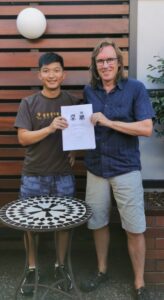November 10th, 2021 by David Wood
Monash University is recognised as a “global leader” in discrete mathematics in the latest research report of The Australian newspaper. Only 20 research groups in Australia (across all disciplines) were given this status.
Nick Wormald was named the top researcher in Australia in theoretical computer science, and David Wood was named the top researcher in Australia in both discrete mathematics and pure & applied mathematics.
Posted in news | Comments Off on Monash, global leader in Discrete Mathematics
October 4th, 2021 by David Wood
James Wilson and Heiko Dietrich.
Group isomorphism is nearly-linear time for most orders.
FOCS 2021.
Jane Gao, Reshma Ramadurai, Ian Wanless, Nick Wormald.
Full rainbow matchings in graphs and hypergraphs.
Combin. Probab. Comput. 2021.
Anthony B. Evans, Adam Mammoliti, Ian M. Wanless.
Latin squares with maximal partial transversals of many lengths.
J. Combin. Theory Ser. A 2021.
Daniel Horsley, Bridget S. Webb.
Countable homogeneous Steiner triple systems avoiding specified subsystems.
J. Combin. Theory Ser. A 2021.
Vida Dujmović, David Eppstein, Robert Hickingbotham, Pat Morin, David R. Wood
Stack-number is not bounded by queue-number.
Combinatorica 2021
Posted in selected papers | Comments Off on Some recent notable publications
September 23rd, 2021 by David Wood
Congratulations to Eileen Pan for completing her M.Phil. degree, supervised by Heiko Dietrich. Her thesis Groups of small order type has also been published in the Journal of Symbolic Computation. Eileen will start a Warwick-Monash joint PhD, supervised by Heiko Dietrich and Adam Thomas.
Posted in graduation | Comments Off on Congratulations Eileen Pan
February 19th, 2021 by David Wood
Today, Tim Chan submited his PhD thesis Substructure Densities in Extremal Combinatorics co-supervised by David Wood and Dan Kral (Warwick). The normal procession to the Graduate School was replaced by a procession to the Nott. Congratulations Tim!

Update 19th June: Tim’s thesis has been accepted!
Posted in Thesis submission | Comments Off on Tim’s thesis submission
December 10th, 2020 by David Wood
The Combinatorics and Graph Theory special session of yesterday and today’s AustMS meeting featured the following talks by group members:
- Ajani De Vas Gunasekara. An Evans-style result for block designs
- David Wood. Stack-number is not bounded by queue-number
- Daniel Horsley. Fraisse limits of Steiner triple systems
And the Algebra special session featured the following talks by group members:
- Heiko Dietrich. Some comments on group isomorphism
- Xueyu Pan. Groups of small order type
- Subhrajyoti Saha. Orbit Isomorphic Skeleton Groups

Posted in news | Comments Off on AustMS meeting
November 10th, 2020 by David Wood
Congratulations to James Saunderson for receiving an ARC Discovery Early Career Research Award for a project “Realising the potential of hyperbolic programming”.
Posted in news | Comments Off on DECRA for James Saunderson
June 5th, 2020 by iwanless
Great news for Subhrajyoti Saha, whose PhD Thesis “Finite p-Groups and Coclass Theory” has just been approved. Subhra was supervised by Heiko Dietrich (with Ian Wanless as associate supervisor). Congratulations Subhra!
Posted in graduation, news, Thesis submission | Comments Off on Congratulations to Subhrajyoti Saha
April 7th, 2020 by iwanless
Congratulations to Kevin Hendrey who has been awarded the 2019 Vice-Chancellor’s Commendation for Thesis Excellence for his PhD thesis
Extremal Graph Theory for Minors, Improper Colourings and Gonality.
Kevin is now a post-doctoral research fellow at DIMAG in Korea.
Posted in news, Thesis submission | Comments Off on Congratulations to Kevin Hendrey
November 25th, 2019 by David Wood
This week group members are organising and attending the MATRIX workshop Structural Graph Theory Downunder at Creswick, 100km west of Melbourne.
Participants:
Maria Chudnovsky (Princeton Uni), Zdeněk Dvořák (Charles Uni, Prague), Gwenaël Joret (Uni Libre de Bruxelles), Kevin Hendrey (IBS, Korea), Tony Huynh (Monash Uni), Nina Kamcev (Monash Uni), Ringi Kim (KAIST, Korea), Tereza Klimošová (Charles Uni, Prague), Anita Liebenau (UNSW Sydney), Chun-Hung Liu (Texas A&M), Natasha Morrison (Uni Cambridge), Marcin Pilipczuk (Uni Warsaw), Bruce Reed (McGill Uni), Alex Scott (Uni Oxford), Paul Seymour (Princeton Uni), Maya Stein (Uni de Chile), Jane Tan (Uni Oxford), David Wood (Monash Uni), Liana Yepremyan (Uni Oxford), Yelena Yuditsky (Ben-Gurion Uni), Xuding Zhu (Zhejiang Normal Uni)

Posted in conferences | Comments Off on Structural Graph Theory Downunder
October 18th, 2019 by David Wood
Congratulations to Heiko Dietrich who has won one of this year’s Victorian Young Tall Poppy Science awards. The awards recognise outstanding research and academic achievement, as well as excellence in communication and community engagement to promote an understanding of science.
Posted in news | Comments Off on Tall Poppy Heiko


